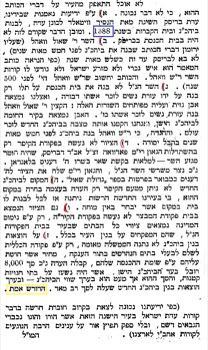In Hatzfira, 27 March 1883, page 86, Rabbi Feinstein responded to the article in Hamelitz 5 March 1883. He disagreed with many facts cited in that article.
 |
Rabbi Feinstein's Response
Blue Rectangle: Year of Prince Vitold Granted Privilege • Red marks: Items Listed • Yellow Rectangle: Signature
By permission of the Historical Jewish Press |
English translation:
... [the text of the article of 5 March is repeated]
As one of the natives and citizens of Brisk, I cannot hold back but comment on what was written in that article because it is not correct.
1. On the basis of reliable records that we have in our hands, the community of Brisk obtained from Prince Witold the right to establish a community and to build a synagogue and a cemetery in 1388. It is obvious that prior to that there was no synagogue in Brisk.
2. Minister R’ Shaul Wahl (hinted at by the writer as the person who built the synagogue 500 years previously), did not appear in Brisk earlier than 300 years ago. (Probably the writer of the article is not Jewish and does not have the information about the biography of minister R’ Shaul Wahl and thinks R’ Wahl lived 500 years ago.)
The actual lifespan of Shaul Wahl: 1541-1617
3. R’ Shaul Wahl did not build the old synagogue. He built only the women’s section next to it, in memory of his wife. The stone plaque was found in the wall of the old synagogue and we placed it in the new synagogue for eternal memory. There is no basis to say that R' Wahl built the synagogue 500 years ago.
4. The drawing was not ordered by the Tzar, but was drawn thanks to the involvement of gaon R’ Meir Padua AB”D of Brisk – a descendant of the Minister mentioned above. Padua sent this drawing to Denis as explained in detail in the book Gdulat Shaul.
5. The plot for the new synagogue was not granted by the Tzar. The community chose that place because in the new city anybody could build wherever they chose; nobody could object.
6. The drawing deposited in the Beit Pkudot [clerk's office] of the fortress was not ordered by the Tzar. It is a customary practice to deposit the drawings of all buildings of the city in the Beit Pkudot mentioned above because that is where the supervision over the general building of the new city is located.
7. The government did not pay the expenses of the construction of the synagogue. There was only a general instruction to pay the owners of the houses that were demolished. The money was calculated on the basis of the assessment of their income. The community was granted 8,000 rubles for the old synagogue as it bordered on small shops. The sum total for those was small relative to the value of the synagogue and the very high expenses entailed in building of the new synagogue.
The article is undersigned:
He who seeks the truth
As the facts cited match closely those in Ir Tehila, we are convinced that the author could have been none other than Rabbi Arie Lieb Feinstein, author of that book.
Below, the newspaper publisher adds:
(We are informed that a new pamphlet will soon be published about the history of the Jews in the old city, a pamphlet that was initiated by the honored gabais of Brisk, and it will illuminate many issues concerning the history of our people in our country.)
Ir Tehila, much more than a pamphlet, appeared in 1886.
Notes:
Free translation by Hannah Kadmon
Schofer: The name of the architect appears in various spellings in print in HaMelitz, in Ir Tehila, and in HaTzfira. It is unclear whether to pronounce it Shofer, Sheifer, Shofir, or Shifer.
Yiddishe Presse: Most probably that refers to Die Jüdische Presse published in Berlin by S. Enoch; Israel Hildesheimer; Hirsch Hildesheimer. General; Orthodox, Supplements: Israelitischer Lehrer und Cantor; Israelitische Monatsschrift; Sabbat-Stunden. Since 1869.
Hatzfira: the Jewish Press site does not support a direct link to the article text. To find it, use the link above, and navigate first to the year, then the month, and finally to Page 7. |


